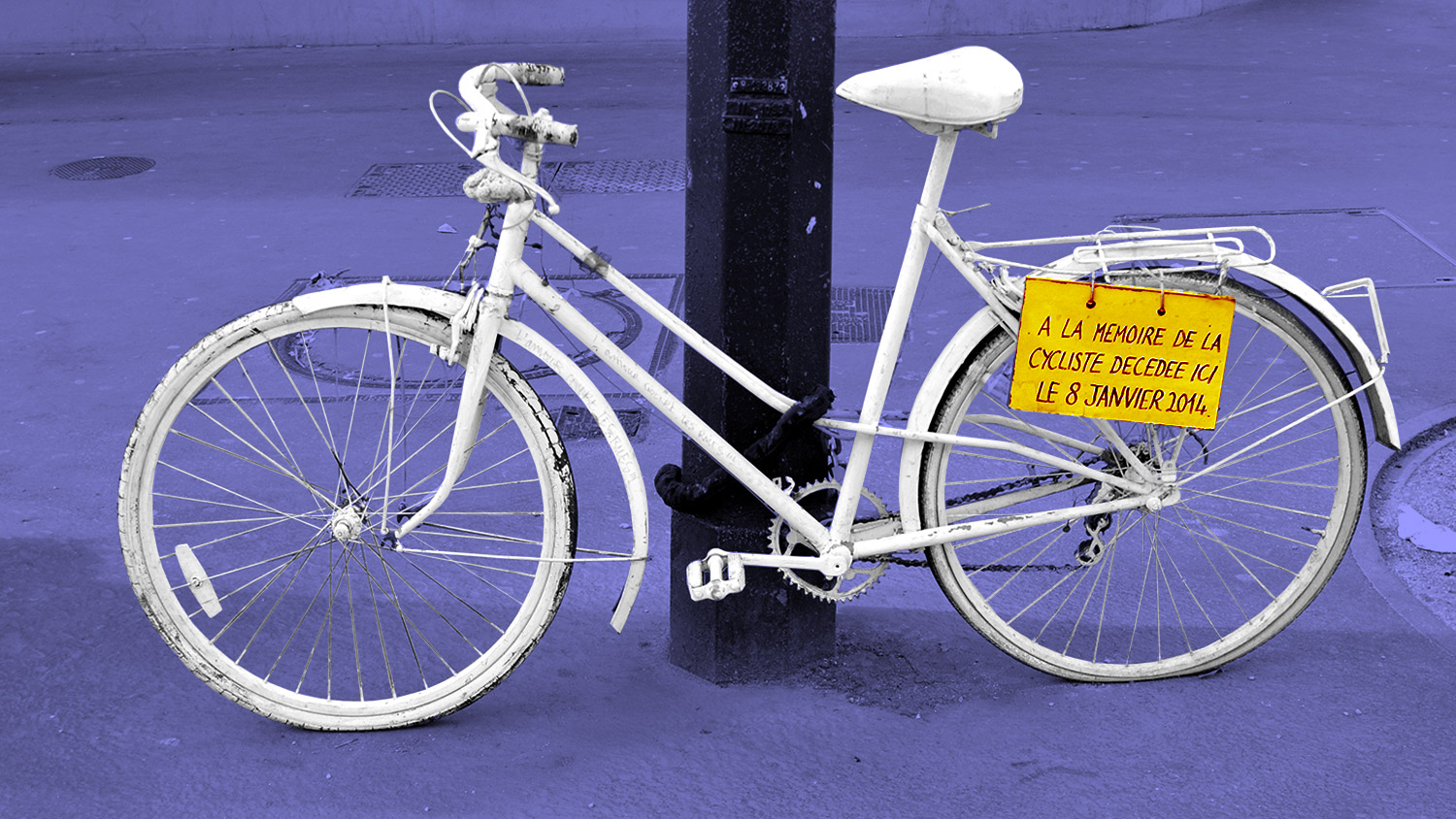You’ve probably seen a ghost bike. Maybe its skeletal white frame, locked to a street sign on a busy corner, blended into the madness of a hustling urban backdrop. Or perhaps the makeshift memorial emanated its phantomly presence chained to a single lamppost along a lonely country highway. No matter the location, ghost bikes turn an indiscriminate patch of road into a solemn reminder: A cyclist was killed here.
These bikes represent a sobering reality. From 2000 to 2013, rates of commuting via bike have increased more than 100 percent in some parts of the country. Fatalities and injuries have increased, too. In 2013, roughly 48,000 cyclists were injured. More than 740 were killed in crashes with motor vehicles. And that’s just accidents reported to the police. Biking, be it in a metropolis or a whistle stop, can be a continuous flirtation with death if you’re not careful. Cities aren’t off the hook when it comes to making streets co-habitable for both bikes and vehicles. Ghost bikes remind city planners as well as cyclists and drivers that simple mistakes can result in dire consequences.
For those who haven’t seen one: A ghost bike is a memorial for a bicyclist who was either killed or seriously hit while riding. The bike is typically put up at or near the site of the accident. Making a ghost bike is pretty simple. Many are resurrected from old junk bikes and stripped of any parts that could be stolen, like cables or breaks. Each memorial is painted white and locked to a street sign at the site of the accident. Ghost bikes often become shrines of sorts, adorned with flowers, votive candles, or other mementos from loved ones or fellow cyclists in tribute.
The very first ghost bike was erected in St. Louis around 2003. According to ghostbikes.org, in 2012 there were thought to be over 630 ghost bikes in more than 200 locations throughout the world, from the Texas Panhandle of Amarillo, Texas, to Minsk, Belarus, in Eastern Europe.
To illustrate how, and just how far, ghost bikes have spread, we talked to some of the major players who helped the movement go viral, and to others with personal accounts of bike accidents or urban cycling experiences. We also crowdsourced photographs of ghost bikes from our Grist readers. The stories (edited and condensed), as well as images from around the world, are below.

St. Louis
In 2003, when Patrick Van Der Tuin was in his mid-20s, he saw a car drift into a bike lane and hit a female cyclist from behind. Her injuries were minor, but the incident stuck with him. The accident was about a block from his home, some place he rode his own bike daily. So he got his hands on a bunch of junk bikes, painted them white, and started combing police reports for locations of bike accidents and fatalities. Originally titled ‘Broken Bikes, Broken Lives,’ Van Der Tuin’s call for cycling reform across St. Louis sparked the ghost-bike movement. Now 36, he serves as executive director of St. Louis BWorks, a nonprofit that provides free bikes to kids in exchange for learning about bicycle safety and maintenance.
Patrick Van Der Tuin
It could have been any color, but white was more powerful. The first [ghost bike] didn’t last 24 hours; it was taken down.
It’s become more acceptable, so we do have a couple that have been up for pushing two years, three years at this point. The families maintain them, which I think is incredible. They were never designed or intended to become permanent memorials, but that’s what those families have turned them into.
The disappointing thing for me was it never became a real tool in St. Louis. Unfortunately, in the last year and a half or so, we have had a horrible rash of fatalities in and around St. Louis. [Ghost bikes] are picking up again.
I don’t think anyone does something like this with the intention of it becoming a model that is repeated and taken around the world on such a grassroots level. I think that’s pretty amazing. I was up in Michigan and I was in what I thought was a very rural area, not anywhere near anything, just camping. I’m driving down the road at 50 miles an hour, this little two-lane road, and my wife is like, ‘Did we just pass …?’ In the middle of nowhere, there’s a ghost bike. I went to New York for a conference and got off the subway, and there’s a ghost bike.
I have a Google Alert set up for ghost bikes, and I will literally every morning read of a different city and read about some individual and some horrific accident. I read about accidents that don’t get ghost bikes all the time, too, but the hope is that the families are getting something out of it. I don’t know whether it’s a memorial or a finger to the municipality that doesn’t want to prosecute the driver, but I hope it’s giving them some voice.
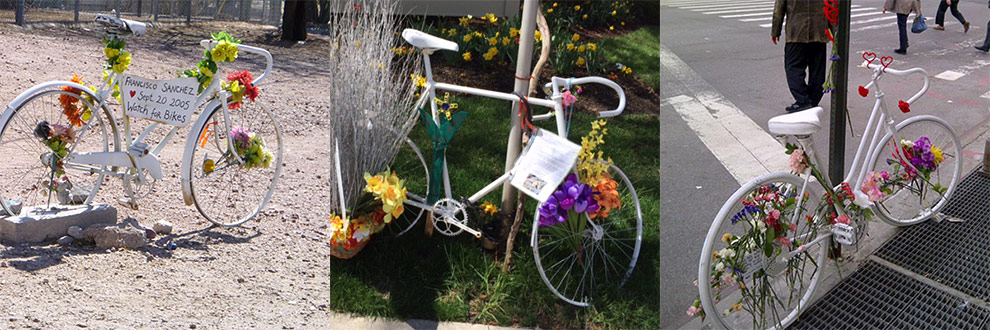

Pittsburgh
Broken Lives, Broken Bikes began in St. Louis, but the term ‘ghost bike’ was actually coined in Pittsburgh. Eric Boerer was part of the small group of people who picked up the movement from St. Louis, got it on its feet in Pittsburgh, and kept the momentum running to New York City. Boerer was running a community bike cooperative called Free Ride at the time. He and his crew registered the domain ghostbikes.org and started placing white, beat-up bikes at intersections and street corners with known fatalities and injuries, mostly accidents their friends had been in. According to Boerer, bike lanes were few and far between at the time; no new lanes were installed between 1982 and 2007. Since then, Pittsburgh has been named one of America’s most bike-friendly cities, and the city is actively installing a system of new protected bike lanes. Boerer had just been hit by a car on his own bike when he started erecting ghost bikes around Pittsburgh back in the early 2000s.
Eric Boerer
My leg was broken pretty horribly. Someone brought up this thing that was going on in St. Louis called ‘Broken Bikes, Broken Lives.’
We had a meeting around a picnic table, basically drinking beers and trying to brainstorm ideas on this project. Someone mentioned ‘ghost bikes,’ because of the connotation that the bikes are gone and they’re ghosts of bikes. Part of it also was that we kind of thought people saw through us, almost looked at us as ghosts on the streets, like they didn’t really pay attention to us. We were almost invisible in a way.
I was just going straight and a guy made a left turn into me. He was in a minivan and he hit me from the side. His bumper broke my leg in half. My lower leg. I rolled up on the hood, smashed his windshield with my body, and slid down. I was in a cast for about four or five months. I had two surgeries, a titanium nail put in to keep my leg straight. I couldn’t wait [to get back on a bike again]. I love cycling. It’s a thing that connects me to my city more than anything.
I remembered feeling pretty excited to put up [a ghost bike] in the spot I was hit, partly in the hopes that the person who hit me drives past it daily and would see it. Part of it was just in the hopes that the city would notice and would do something about the state of cycling in the city. I remembered feeling very determined to be the one to put that bike out and be the one to lock it, carry it out there, and just look at and be like, ‘Goddamn this person for messing up my year and messing up my life.’
This was sort of pre-crazy internet, you know, it was like 2003, so it was a wild moment for a lot of us to see something go viral before there was a term called ‘going viral.’
I’ve personally seen ghost bikes. I saw them in Mexico City. I saw them in Santiago, Chile. It’s kind of amazing to even see that in person around the world. I’m sure just about every big city in the world has one at this point, at least one.
You see how important they are to their family members, who may not have ridden bikes, may not have cared about bikes, but they knew cycling was really important to their family member. Now it’s important to them, too.
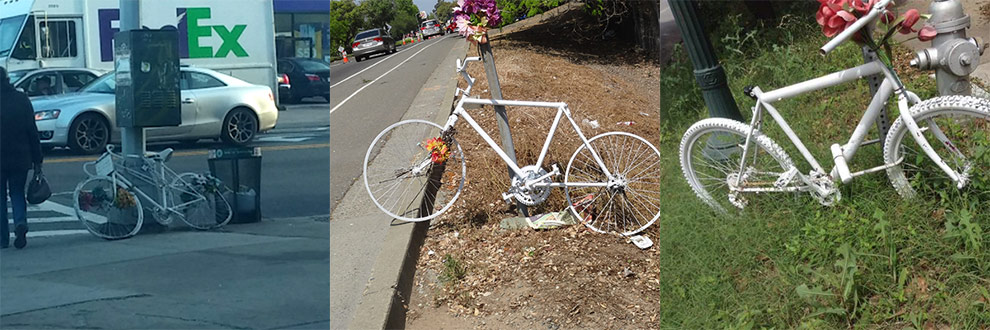

North Carolina
Aimée Argote was driving home from a concert the night of Sept. 19, 2013 with her partner, Taylor. They were near Chapel Hill, N.C., on a well-traveled, four-lane highway divided by a median that connects Durham, Chapel Hill, and Pittsboro. The speed limit wasn’t much higher than 45 or 50 miles an hour. The weather was clear. Suddenly, they came across two lumps in the road. It was Alexandria Nicole Simou and Ivin Levander Scurlock, two victims of a hit-and-run. Scurlock died on the scene, while Simou later died at the hospital. For a while, Argote, a touring musician, couldn’t drive at night. In the two years since the accident, she’s barely ridden her bike. The ghost bikes she helped erect for Simou and Scurlock have since been taken down, and the case regarding their accident still hasn’t been solved.
Aimée Argote
I just thought garbage bags had flown out of the back of a truck. But then we saw these two bicycles in the middle of the road.
It was hard to recognize that he was dead because he was so warm and we [were] checking for breaths and stuff. There was somebody else right next to him who was clearly alive. She was unconscious and in a big pool of blood and just wheezing out blood. I was just hugging her and asking her to stay with us.
Their bikes were smashed together so tightly that it looked like one bike.
The first cop showed up and started freaking out, waving her flashlight around. It was pretty obvious that she had never seen a dead body before. One of the policemen, this was one of the most bizarre parts about it, came up and said, ‘I’m sorry, but I have to inspect your car.’ It was the most frightening thing. He had to make sure it wasn’t us that had hit them.
They were wearing bike lights and they were wearing safety vests. Their bikes were smashed together so tightly that it looked like one bike.
Taylor and I both realized that the best way to honor them was to remember them with warmth and love and not fear. And to become a better driver and figure out what it means to be a better driver. So many times in the van, [I see] somebody is driving and they’re texting. I had texted and driven before and I was just like, ‘Never again.’
My friend Jason runs a bike shop and he was actually the person who suggested the ghost bikes. He has a bunch of old bikes and so he got the bikes ready. They took the bikes down after, like, three or four months. The year following, we organized a ride that started at [Jason’s] bike shop, and we rode down to the spot with two new ghost bikes and just encouraged people to bring flowers or Mardi Gras beads or anything colorful to decorate the bikes with. Then they took the bikes down again.
We pretend like cycling is a privilege for people who want to put on racing shorts and buy $3,000 bikes. I think it’s an important reminder to the city: What are you spending your tax dollars on? Can you please spend it on protecting people who are just trying to get home, just trying to get to their kids, just trying to get to work? Before the accident, when I would pass a ghost bike, I would just take a moment to become more present in my vehicle. I always passed it and thought, ‘Oh, somebody died there.’ It was a fleeting thought sometimes, but I always had that thought. Now that I’ve been a part of an accident, I pass them and I think, ‘Thank God, I’m not the only one who remembers.’
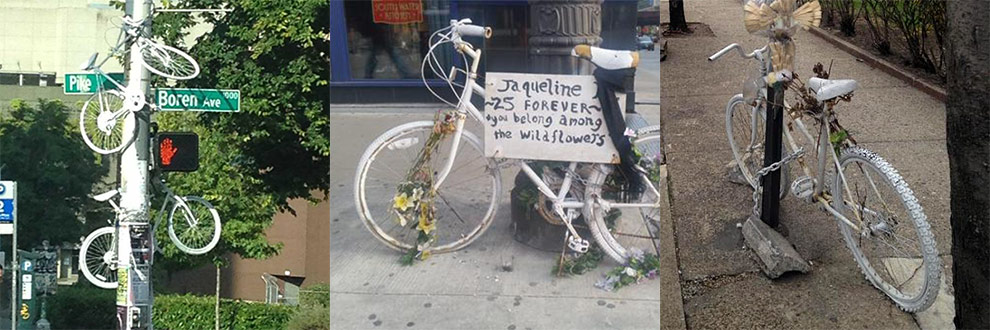

Seattle
Scott Kubly had been on the job as director of Seattle’s Department of Transportation for roughly a month before a cyclist was killed in a notoriously dangerous bike lane. Sher Kung, a 31-year-old attorney and mother, was riding down Second Avenue in the heart of downtown Seattle last August — a stretch once described by a Rutgers University bicycling scholar as “death-defying” — when she was hit by a left-turning box truck. Her death took place less than two weeks before a new protected bike lane was expected to be completed. Over the next five years, Seattle hopes to install more than 35 miles of protected bike lanes, and eliminate fatal and serious collisions within the next 15 years — all part of the Seattle Bicycle Master Plan. But one of the city’s biggest challenges overall is the antagonistic attitude between drivers and cyclists, says Kubly. A ghost bike was erected in Kung’s honor at the site of her accident.
Scott Kubly
I think that for whatever reason there is an antagonism between bicyclists and non-bicyclists in this city that is probably stronger than in any other city that I’ve been in. It’s really actually shocking. It’s a real angry kind of dialogue. We’re coming out of what, locally, people call ‘the mode wars,’ where people of different modes [of transportation] were kind of fighting amongst each other and not really recognizing that we actually live in a multi-modal city where all the things need to work well together.
The riders I see here in Seattle are really different than riders I’ve seen in other cities. I think they ride more aggressively here than in other cities, I really do. If you go to D.C. or Chicago, where the bike-commuting culture and the bike-riding culture is a much calmer riding culture, you see a lot fewer people in spandex and a lot more people in regular street clothes.
People who don’t like bikers are going to say, ‘Look at how obnoxious that biker was,’ and people who ride bikes and get frustrated by cars are going to say, ‘Look at how obnoxious that driver was.’ It’s so funny because Seattleites are so nice in so many other ways. I truly can’t figure it out.
Whenever we have a traffic fatality, I’m aware of it, and we’re doing everything we can to minimize them. When I get a traffic crash report across my desk that shows that somebody died, personally, as a DOT [department of transportation] director, and I’m not saying every DOT director is this way, but I don’t need a ghost bike to let me know that doing work to improve safety is critical. I think where they probably serve a purpose is a reminder to the general public that somebody died unnecessarily.
Sadly, I would say [of the cyclist fatality on Second Avenue in Seattle] that it’s not the first time something like that has happened. And it’s not going to be the last.
When I was in Chicago, we had two crashes that were really similar in circumstance. There was a person who was riding their bike down Wells Street [and] they were traveling in the door zone. A car door swung open, so they swung out of the door zone to avoid getting doored. They happened to get caught up under a truck and they died. It was a matter of weeks before the street was [going to be] repaved and we were putting in a buffered bike lane, which would have had a buffer in the door zone, but not for a couple weeks. There was a kid named Bobby Cann, who worked for Groupon, I believe, and he was riding down Clybourn Avenue in Chicago. We had been as a city DOT going back and forth without getting permission to put a protected bike lane on Clybourn Avenue. This is three years ago, four years ago at this point, but it’s finally going in right now. This kid gets hit by a drunk driver and it severs his leg, and he dies right there on Clybourn Avenue. If the protected bike lane had been there, he would have been alive.
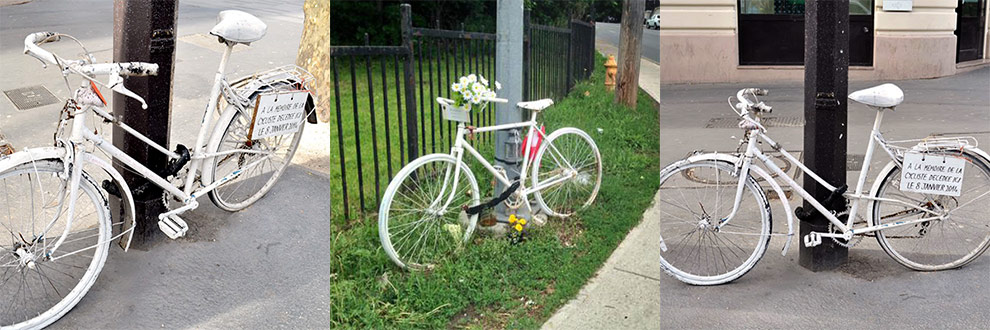

New York
The urban biking movement is slowly reversing the last 50 or 60 years of automobile culture, says Doug Gordon — the blogger and biker activist behind Brooklyn Spoke. Ghost bikes, part of that movement, draw much needed attention to serious problems like road rage, poor street design, and lags in transportation infrastructure. But ghost bikes aren’t the only — or most effective — PSA to promote bike safety. In fact, Gordon says they could inflate how dangerous biking really is.
Doug Gordon
I recognize how important and how impactful a ghost bike can be. I think if a person dies, it’s understandable to want something tangible, something concrete at the site where they were killed.
They also can do a really great job in drawing attention to a pretty serious problem, which is the deficiency of design on our streets, road rage, poor driving choices, whatever it is. I think they can be really good at grabbing the attention of an elected official. No one would want the distinction of having the most ghost bikes in their district.
My fear of ghost bikes, sometimes, is that they can make bicycling seem more dangerous than it is. The statistics probably don’t spell out that fear as being completely reasonable, but when you put [a ghost bike] there in front of people, it does run the potential of scaring people off from biking and choosing biking. They’re not necessarily the best tools for talking to people who don’t already consider themselves cyclists or who don’t already ride a bike on a regular basis.
I don’t think there’s any kind of prescriptive like, ‘Here’s what you can do to promote biking, or to convince people that it’s safe.’ There’s no sort of prescriptive measure you can take to do that.
For some people, getting involved with a ghost-bike project is their entry into more general bike activism, and in that regard then the ghost-bike project really is serving a fantastic purpose, it’s energizing them and getting them more involved. I don’t know a single person who is involved with a ghost-bike project who sees spray painting a bike white, putting it up with some flowers, and holding a ceremony as the start and end of their bike advocacy.
It used to be that the ‘bike people’ were seen as fringe. Maybe you had a buddy who went to Amsterdam and told you how great it was, or someone moved here from Long Beach or Davis, Calif., which have been really good bike communities for a long time, and told you, ‘Oh, there’s a better way.’ I think with the rise of social media, Facebook, Twitter, we’re able to share best practices from around the world and say, ‘See? This is how it works over there. Why can’t it work here?’
I have a very low threshold for risk. I have two kids and I ride with them, too. With biking, I know the statistics and I know I’m pretty safe overall. I also know generally which streets on my commute to work, for example, are best to avoid. I’m not saying I never run red lights, but I’m certainly not going to do it at a huge intersection where there are tons of cars and lots of people crossing. I also ride a big clunky Dutch bike, probably heavier than a city bike, so I’m not racing through the streets on my fixie or a racing bike. I’m always traveling at a predictable speed. Sometimes, I probably feel more exposed in New York City when I’m crossing in the crosswalk. I’m more afraid that a driver is going to speed around the corner and hit me as a pedestrian than I am riding my bike.


Portland
According to Jeff Mapes, bicycling is an indicator when it comes to judging the health of a city. Mapes, a senior political reporter for The Oregonian, is also the author of Pedaling Revolution, in which he chronicles how biking is creating a “new society on the streets.” He lives in Portland, one of the most bike-friendly cities in the country. Approximately 6 percent of the city’s commuters bike to work — about 17,000 people — which is the highest percentage of bike commuters in any large city across the country. A longtime bike commuter, Mapes says there are tons of bike safety campaigns throughout the U.S., but perhaps nothing as impactful as a ghost bike.
Jeff Mapes
I think [biking] has contributed to cities becoming lifestyle places. It’s a sort of chicken-and-egg kind of thing. I think the bike movement is both a cause of that, and also a result of that. One reason people want to move downtown is because it’s more doable and more interesting to bike, and that in turn puts pressure on cities to be more bike-friendly. You’re seeing a virtuous cycle in many ways.
I think bicycling is in someway an indicator species almost for the health of the city.
There is some added risk to cycling than most other modes of transportation, I think. It doesn’t necessarily have to be that way. In the Netherlands, they’ve really concentrated hard on bike safety and almost nobody wears a helmet there and they have very positive safety records. So clearly it goes way beyond encouraging helmet use.
I’m 60 now, and I have to say, there’s a lot of 20-somethings who go flying by me and I think, “Man, they feel like they’re immortal.” I do ride more cautiously.
Everybody has drivers training, very few people have cyclist training.
In my experience, when you’re in a bike lane next to vehicles that are going much slower than you, you’ve got to really watch it because you’re in danger of right hooks. I once saw a guy get his collarbone broken. He was flying down a bike lane and a car saw an opening in the traffic and stepped on it, and he just came flying through and smashed right into the cyclist.
Nobody really teaches you how to ride a bike in city traffic; you just learn how to do it. One thing I learned researching the book that I was very interested in, is that there are smart ways to ride in city traffic, but nobody teaches it to you. At least when you’re in high school, you take driver’s ed to get a license. Everybody has driver’s training, very few people have cyclist training.
There are certainly lots of safety campaigns. The Netherlands, one thing they do every year, they do a big safety campaign getting [bikers] to use their lights when the fall starts because it starts getting dark earlier. That, they say, is a huge cause of many crashes: cyclists without lights. Certainly, here in the U.S., we have the “share the road” signs and bumper stickers and posters and things like that, but they probably don’t have the visceral impact that a ghost bike does, that’s for sure.
Through the years, I think there’s been some feeling about ghost bikes portraying cycling as a dangerous activity. One could argue [they] certainly send the message to a lot of people that cycling is very dangerous.
I do think it’s sending a message that cyclists’ lives matter, so I think that’s important. I think a lot of times, for people who don’t cycle, it’s easy to say ‘Well, that won’t happen to me.’ Ghost bikes do help send the message that, ‘Yes, this does matter.’
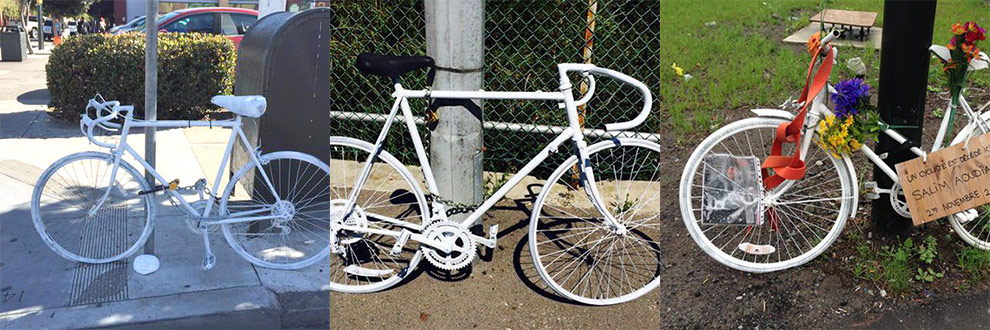

Los Angeles
Biking, according to Adonia Lugo, is much more than just a weekend hobby, or a trendy, spandex-clad exercise fad. Lugo, an urban anthropologist currently teaching a course on urban infrastructure at Antioch University Los Angeles, studies how transportation — biking in particular — can be a transportation-justice issue. Throughout the course of her studies, Lugo has noticed that the connection between biking, race, and class isn’t as apparent to some of her fellow scholars and activists as it is to her. For them, she says, the real goal is about making sure everyone has access to greater mobility, like cars and better transportation networks. To Lugo, the issue is a bit more complicated than that.
Adonia Lugo
Within bicycle advocacy or the bike movement broadly, there is a longstanding tension between direct action and more institutional avenues for promoting bicycling. On the direct-action side, you have kind of a long history of street theater related to bicycling, like the group in New York, Time’s Up. Decades ago, they started doing street theater, trying to call attention to vulnerabilities on the street. A really good example is the ride Critical Mass, where people get together and use their bodies to actually disrupt space and say, ‘We deserve to have access to this road.’
I see ghost-bike memorials fitting into that sort of direct-action tradition in the bike movement, because they are there to serve as a reminder about the ongoing vulnerability of people who are using bicycles in that area.
A lot of people I know, myself included, who get involved in bicycle activism are motivated by a very personal experience of feeling marginalized in the streets. We’re coming at it from this very visceral, personal knowledge that we’re not necessarily safe in these car-dominated streets.
The idea of public memorials is more culturally accepted in some groups than in others. For example, I’m from a very Latino part of southern California, and it’s very common where I’m from and where I live now in L.A. to see cars that have memorials that say, ‘Rest in peace,’ and somebody’s name and their birth and death year. There are murals all over town that memorialize people, and then of course we’re all familiar with highway roadside memorials.
I see ghost bikes fitting into that genre except that what’s unusual about them is that those sorts of memorials are usually very personalized, they have to do with a family or a community that lost somebody, and ghost-bike memorials can be personalized. But they’re also trying to tap into this larger pursuit of bicyclists being more vulnerable.
I think the ghost-bike memorials probably play a greater role in giving people a common cause than they do in increasing the perception that cycling is unsafe.
Car culture creates all sorts of enmity between different car users
Something that’s not often talked about as one of the pillars of why we have suburban sprawl today was that desire to get away from social undesirables. The fact is that access to driving and being able to be inside a car is a huge status symbol.
Sometimes, I think that when people are saying [biking] is unsafe, what they mean is that it’s not very respectable. They’re also expressing a total lack of embodied knowledge. Car culture creates all sorts of enmity between different car users, so if you’re accustomed to just being in the car and seeing how recklessly some people drive, I think it makes sense that you would assume I’m safer in my car then I would be out there, unsheltered on my bicycle.
I’m mostly interested in accessing bicycle users who are very low-income or who are people of color; people who are doubly marginalized are already more vulnerable out in public space, and then they also are riding a bicycle.
When you talk about these transportation choices, you’re getting into a really complicated world of how we express our social status.
What I’ve learned through studying and participating in bicycle advocacy is that there are a lot of people out there who are not that familiar with these issues, because they themselves have not known what it’s like to not have access to a car. If you do know what it’s like not to have access to a car, it can be very embarrassing and very shameful.

Have your own ghost bike story? Share it in the comments below, or tweet it to @grist with the hashtag #gristghostbikes.

